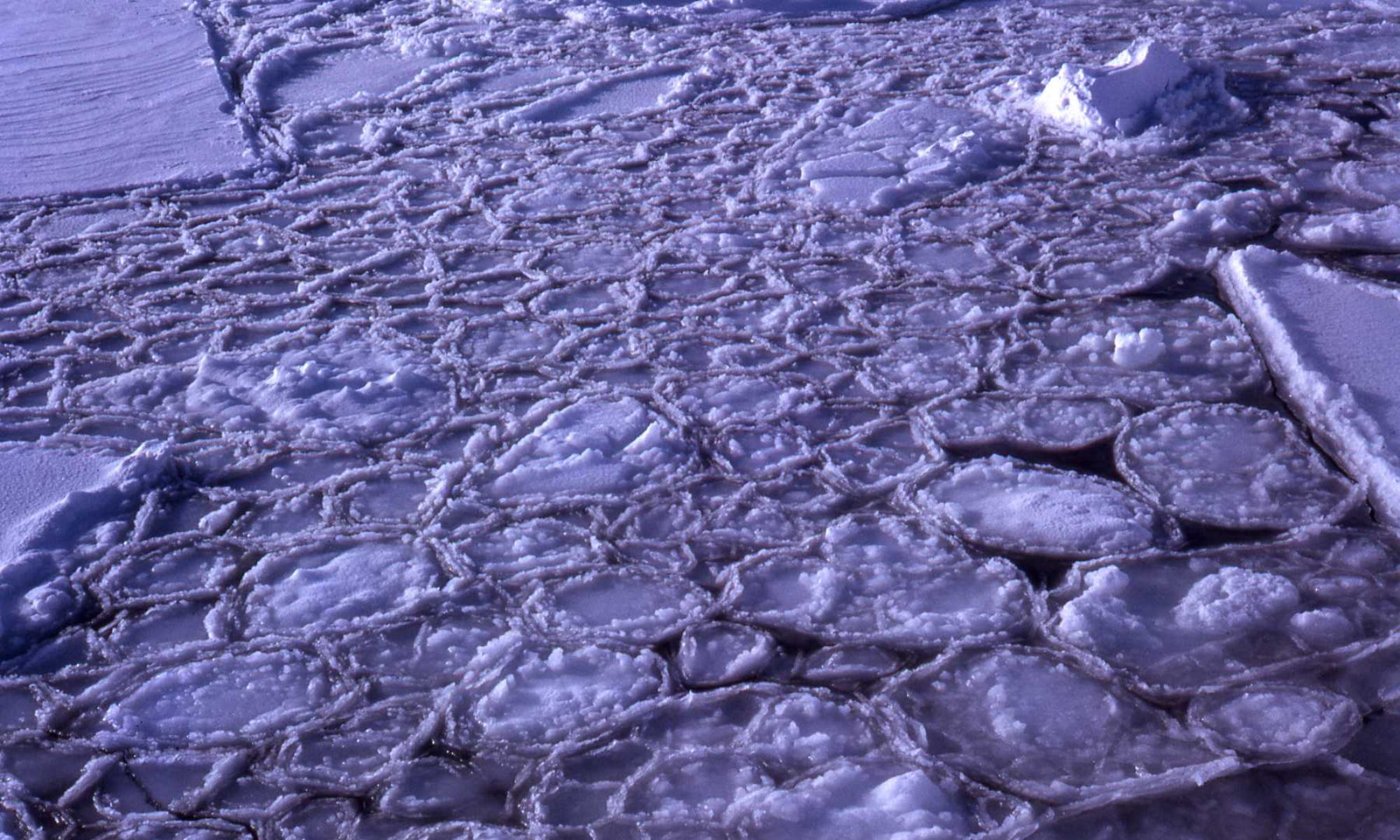Becoming a FID – Rod Pashley
(An overview from my diaries, official reports and letters home of 2.5 years in Antarctica, Winters 1969 & 1970 – including each year’s Summer Surveys and other memorable events/journeys)
1! pause… 2! pause… 3! pause… Three loud blasts from the bridge on the RRS John Biscoe’s ships horn as we left Southampton for Antarctica – Wednesday 23rd October 1968. I would finally arrive at Base T (Adelaide Island) on Saturday, 8th March 1969.
I would be away from the UK for 2.5 years, spending 2 consecutive winters and 2 summer surveys travelling and working on the Antarctic Graham Land Peninsula. Full of excitement and anticipation (as I’m sure others were) it was hard to believe I was on my way. This was the start of becoming a FID! The title had to be earned (time-served) and I’m proud to be one and feel immensely privileged to have been given the opportunity to have such an important formative experience. I was 21 and 10months old, heading South to be a G.A. at Base T (Adelaide Island). I was 22 by the time we reached Adelaide Island. I was 24 on my return to UK.
So how come I was heading South; what had the ‘journey’ been to get me here. It wasn’t planned in advance, although I did apply when I was 18 and told I was too young and to try when I was 21. However, the desire to seek out adventures and challenges; wanting to gain more understanding about myself; having a strong interest in the natural world; having a passion for mountaineering; influences from a number of years being a member of the Scout movement and also experiencing a 24 day Outward Bound course at the age of 15; lots of love and encouragement from my parents. All of this contributed to my personal development and me being on the John Biscoe having been interviewed by Bill Sloman and Sir Vivian Fuchs at the BAS offices, Gillingham Street, London.
I was born in Barnsley, South Yorkshire, into a loving family, on 16th January 1947 (one of the harshest winters the UK had experienced at that time). My brother Roger was 2 years older. We lived in a small, terraced house as a working-class family. Dad was a steel worker and Mum worked but with plenty of countryside and country lanes close by made it easy to get out into the local countryside. Dad, a quiet, gentle man was always at work as other Dads were, but he did take us to see a number of films which, I believe, were quite significant in influencing me – The 1953 ascent of Everest; the 1958 Crossing of Antarctica (Fuchs & Hilary); the Kon Tiki expedition; the films ‘Cockleshell Heroes’ and the ‘Dambusters’. On reflection these were all about endeavour, adventure and challenge, so not surprisingly a big influence on a very young Pashley – a sociable young chap, extrovert, confident and a people person but at the same time a little unsure about himself.
Academically, my parents didn’t place any great expectations on my brother and I but focused on supporting us in anything we pursued and engendering values of kindness, honesty and respect. We both joined Cubs and Scouts; learned to play instruments; Roger violin and me trumpet. We both had an arts bias which for me included drama, and not a technical bias. I remember on a number of occasions being labelled a dreamer – a romantic. Needless to say I failed my 11+ and left school at 15 but continued immediately into further education, gaining more ‘O’ levels, after 2 years, than my mates who had gone to Grammar school. At Racecommon Road Secondary modern school the teachers were fantastic – inspirational; organising and printing a school magazine where we could all contribute; running extra-curricular evening activities and one year a week’s summer camp.
We were never given homework but the curriculum was full of the 3 Rs, Art, Geography, History, Music, PE, Science, Metalwork, Woodwork and gardening. Yes, we all had a strip of garden. This was to prepare us/engender an interest in, perhaps in the future, of having an allotment after work like most miners and others had; an opportunity to get some fresh air in your lungs after working in the Pit or Steelworks. School was a very positive and supportive environment and I got fully involved thriving and growing on the way. There were those adults around me; well-intentioned and supportive who saw a future for me as a teacher. However it was clear, later on, that I was going to break the status quo bubble of that expectation of Teacher Training College, job, marriage, family etc. I had another vision/dream.
The journey South on the RRS John Biscoe was a wonderful experience and the start of that other vision.

Everything was new, exciting, fun, sometimes tiring, sometimes boring; overall, intensely stimulating, gifting me many, multi-coloured memories. I believe the journey South was an excellent opportunity to get to know others; those from different backgrounds, education with different skills and experiences. Living together, on board, in such a tight social environment engendered the need to be conscious of the impact, both positive and negative, that we potentially could have on each other; great preparation for wintering. The journey involved many visits and events starting with crossing the Equator and the associated ceremony; arriving in Montevideo and Stanley in the Falkland Islands; Punta Arenas, Deception Island, Liege Island; South Georgia, and Christmas in Potters Cove (South Sandwich Islands with HMS Endurance).

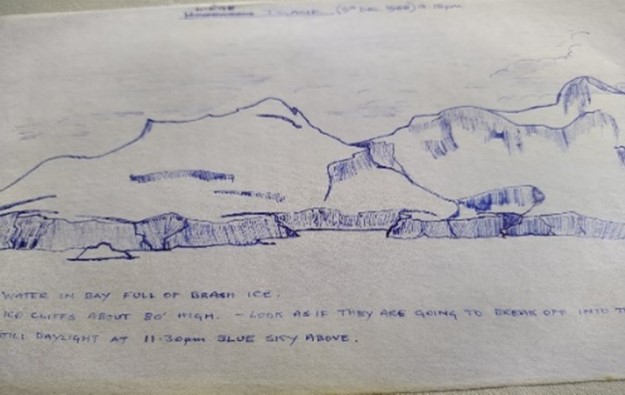
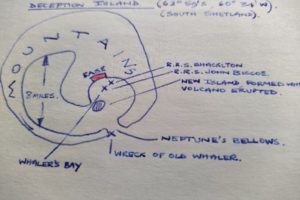
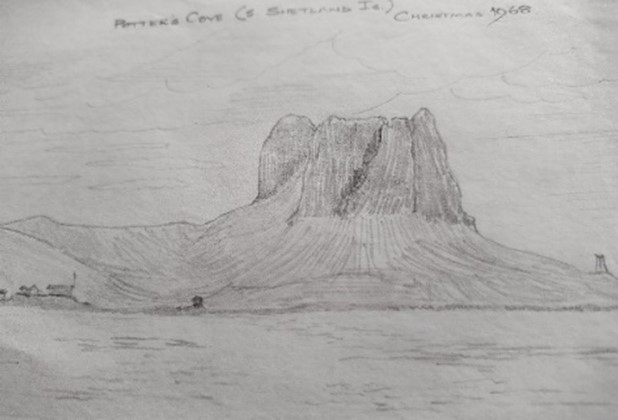
Calling in on bases at Signy Island and Argentine Islands. Sailing down the wonderful Lemaire Channel; Sealing for dog food; depot laying in Marguerite Bay; Stonington Island; external painting of Horseshoe Island Base.





We also had an early venture south to assist with trying to position one of the BAS aircraft that had gone missing. We eventually hit pack ice which became heavier and halted our progress. Eventually the aircraft was found on the Larsen Ice Shelf with all those on board safe and well.




Finally, I arrived at Adelaide Island (Base T) 8th March 1969 where I disembarked. This would be home for 2 Antarctic winters.
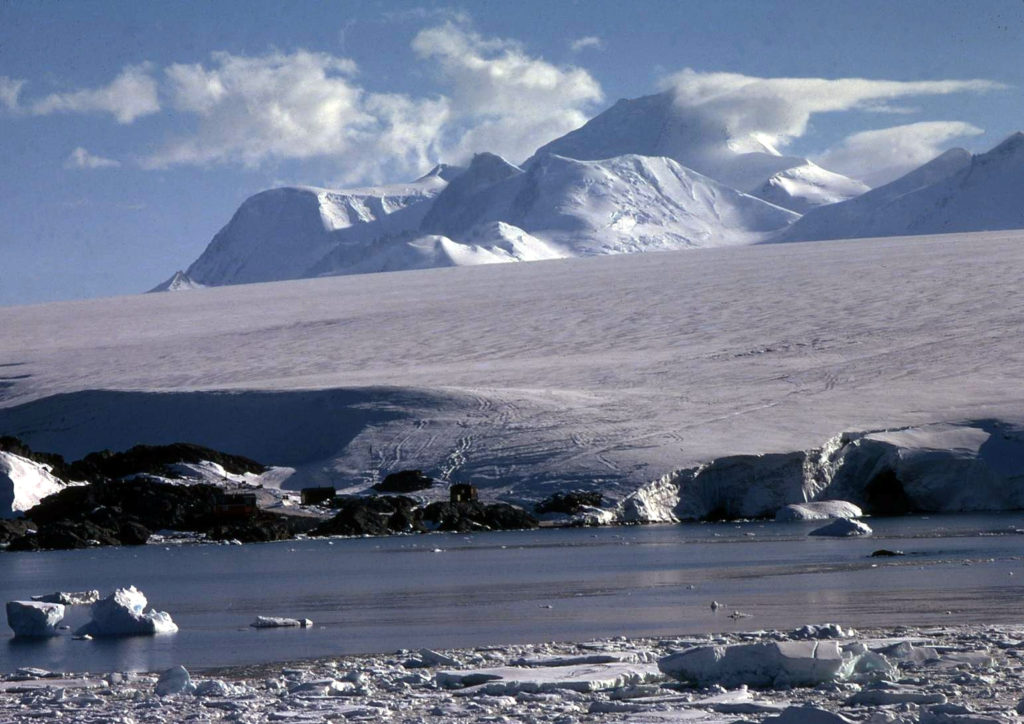
Two years with a bunch of great guys. It was clear that I would spending more time away from base than on it.


Ian Curphey’s comments below sets the scene. Ian and I were both GAs and were keen to get on with the job. Ian would run the Huns and I the Picts. Ian had an experienced lead dog, Count but I had Inca who was new to leading. This was challenging for me but gradually Inca became a great leader as the days, weeks and months progressed. In my second year she was fantastic – very experienced.
Extract from Ian Curphey’s paper. Marguerite Dog Sledging Trips 1969
“On arrival at Adelaide Base T in the autumn of 1969, there was a surprising lack of dog sledging know-how available to induct incoming Fids. This was mainly due to the particular nature of the outgoing dog-man, Bugs McKeith, who had been proved to have little interest in the twenty plus dogs for which he was responsible, and had decided to terminate his contract a year early.
Once the two-year-served, outgoing Fids boarded the Biscoe, the only people with any sledging experience were Ian Willey and Martyn Bramwell. However, Ian would find it difficult to spend time in the field because he was now Base Commander, while Martyn’s experience was solely based on limited time spent with Graham Smith’s team during their forced sojourn at Fossil Bluff the previous winter. This was a serious issue for myself and fellow GA, Rod Pashley, as the two Adelaide dog teams, the Huns and the Picts were required to support the Stonington sledging programme scheduled for the 1969 field season.

Acquiring the dog handling and field experience necessary to carry this out was traditionally achieved by the new GAs learning the ropes from an experienced dog driver completing his second year. With the support of other base members (but particularly Ian Willey), Rod Pashley and I needed to spend as much time in the field as possible over the coming autumn to teach ourselves, essentially by trial and error – a difficult, frustrating and inefficient process. Fortunately, the essential aspects of BAS dog sledging methods had not changed significantly from the well-documented systems developed by Rymill and Bingham (photo left) during the British Grahamland Expedition 1934-37, and further developed after 1947 by a succession of FID GAs under the guidance of Bingham”.
Over the next 4 months we travelled on the Adelaide Piedmont and the sea ice on single and numerous, multiple day journeys accompanied by base personnel; a great opportunity for them to experience sledging and polar camping.



Involving the non-field personnel engendered a strong enthusiasm for recreational travel with the ‘Rabble’ team; a small group of young dogs and old ones; with a huge fondness from everyone involved; giving hours and days of pleasure. Adelaide Island proved to be a great place to train our teams with plenty of opportunity to ‘learn our trade’ along with plenty of natural hazards and of course the extremes of Antarctic weather to test our travelling skills and systems



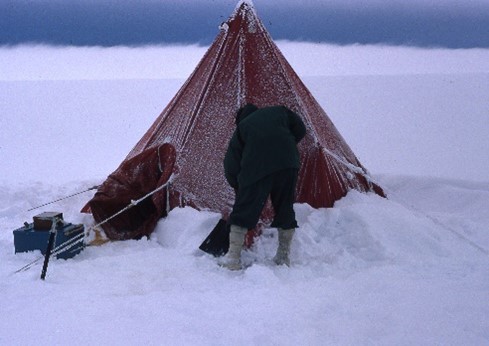

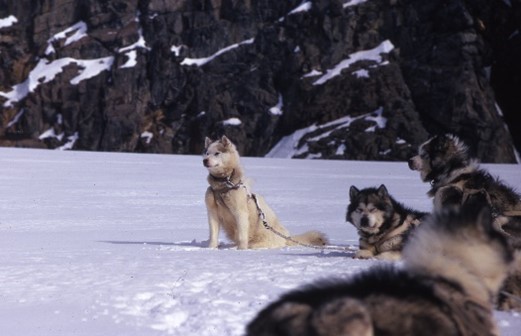
For Ian and I getting our dog teams fit, honing our skills and preparing our equipment for the summer surveys to support the Stonington teams was vitally important. Building 2 new sledges and creating 2 full sets of field gear was very practical and satisfying. That was our focus and our hard work paid off with the following map showing my major journeys and work areas (shaded), and many other shorter journeys, over the 2 years. Both years I supported Geologists and over 2 years, in total, sledged over 4,000 miles and spent over 402 days in the field.
Meanwhile on base everyone was dedicated to their respective jobs with great leadership provided by Ian Willey winter 69 and Richie Hesbrook winter 70. The quality of leadership definitely determines the culture and atmosphere on base and neither Ian W or Richie H were lacking in this regard. Of course there was always enthusiasm for the odd party and fancy dress was normally the order of the day.
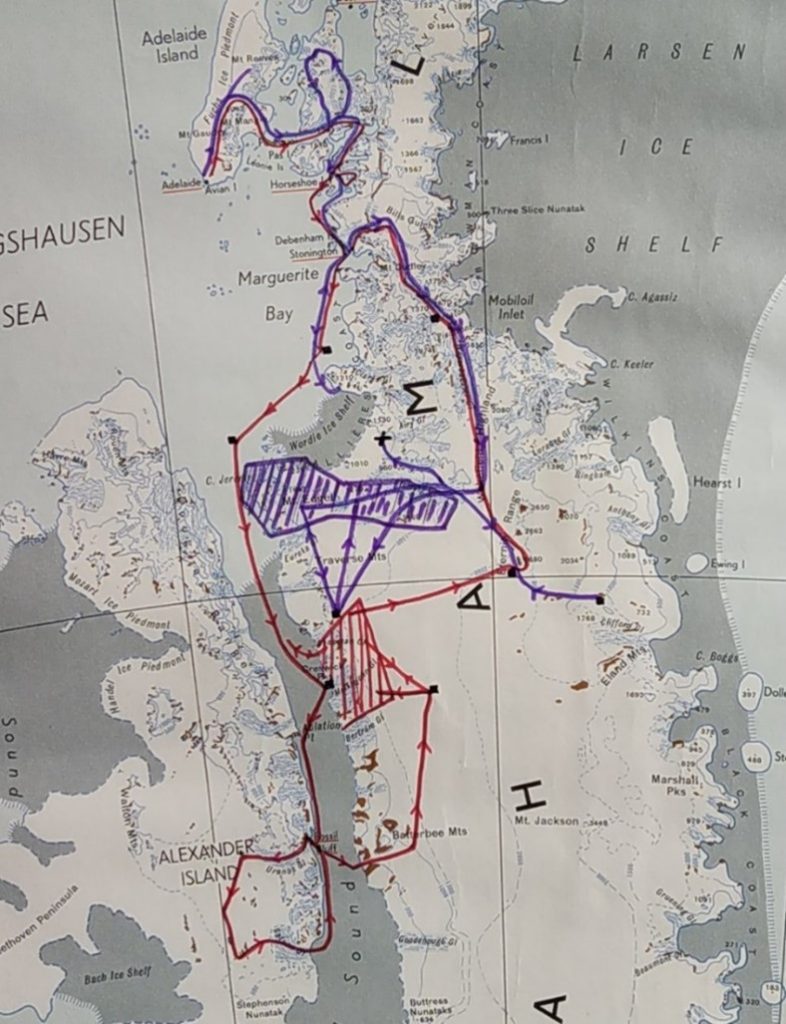


1969 – Journey from Adelaide to Stonington
Coming soon…..
1969 – Journey from Stonington To Fossil Bluff
Having arrived at Stonington on the 14th August we had spent 21 days preparing our equipment for our big trip; short runs to train Inca, supported at times by Ian ‘Spike’ Sykes, who knew how frustrating it was to take over a group of dogs that needed working into a team. Feeding up the dogs on seal meat and generally entering into the social life on base filled our days.
On 5th September we finally left Stonington heading to Fossil Bluff on the first part of our Summer survey. Sledge Echo (Tony Bushell GA with the Komats and Peter Rowe Geologist); Sledge Foxtrot (Ian Sykes GA with the Vikings, Myself GA with the Picts and Ali Skinner Geologist). We were the first to leave base on Summer Survey and would arrive at Fossil Bluff on 26th September after a journey of 256.3 miles


Our first day was a good run of 23 miles in 6.5 hours placing us just 14 miles north of Terra Firma. On route we had to negotiate 4 wide cracks in the ice, exposing open water. Inca was beginning to lead well and my worries about her subsiding. As the days progressed we had both good running days and poor days; deep soft surfaces; a number of days lie up and negotiating heavily rifted areas at the edge of the Ice shelf. Our route took us past Terra Firma island, Mushroom Island, the Puffball islets and on past Cape Jeremy. After the Puffballs we had shorter travelling days and thereafter poorer conditions. At times Pete Rowe was out ski-ing in front of the lead team to encourage them.
Once into the King George VI Sound on 19th Sept we had good running to Fossil Bluff. On our approach it was difficult to see the base but once there it was a delight to step through the door into a cosy haven.

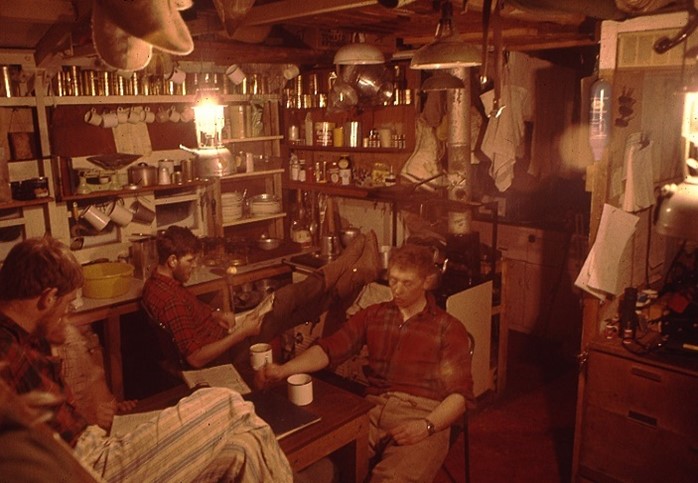
Our time at Fossil Bluff would be a time for regrouping, resting, weighing the dogs and for me more training of Inca
1969 Journey on Alexander Island
After Sledge Echo and Sledge Foxtrot arrived at Fossil Bluff on 26th September, it was time to rest, regroup and prepare for the journey into our working area on the Graham Land Peninsula. To this end, whilst Pete Rowe and Ali Skinner (both Geologists) prepared for their survey work, in the meantime Sledge Echo (Tony Bushell, Ian Sykes and myself) went out onto Alexander Island and laid a depot at Titania Nunatak for the Geophysics work that summer. It was also an excellent opportunity to look around the area, taking advantage of the excellent weather and surfaces. A big difference from conditions from Stonington to Fossil Bluff.
On October 5th we left Fossil Bluff and headed up the Uranus Glacier, eventually leaving manfood and dogfood at Titania Nunatak. The weather and surfaces were excellent and we were able to cover 27.2 miles in good time. The next day (6th) we climbed Titania by the south face and then moved southward and camped by an impressive ‘thumb-shaped’ tower nunatak we called the ‘Tick’. Another great travelling day of 23 miles. The next day (7th) we climb the ‘Tick’ by its very steep south face and then moved south around the Mimas peaks and to end another great day after 26.7 miles.
October 8th saw us enter the Saturn glacier, eventually camping at 6.00pm near Two Step Cliffs after 23.9 miles. Eventually Sledge Bravo (Norman GA and Mike Burns Geophysicist) arrived enroute to Coal Nunatak. On October 9th we left camp at 10.15 and headed back to Fossil Bluff. Although a very cold day from a northerly wind the surfaces were excellent and we arrived at 8.15 pm having covered a distance of 42 miles! This was the longest day and distance that any of us had travelled with dog.

1969 – Summer Survey Area – Rod Pashley
After arriving back at Fossil Bluff on the 9th October we quickly regrouped and reformed the geological working parties. Sledge Echo would now comprise Pete Rowe Geologist, Tony Bushell GA and myself GA. Tony would make the plane-table map of the work area and I would support Pete with his geology work. Sledge Foxtrot comprised Ali Skinner Geologist and Ian Sykes GA. Each team would be working in separate areas. A depot, named ‘Porter’, was laid in 1968 by air, on the plateau, and both Geology teams would work out of that until we could get further air support later in the summer.

On 12th October we left Fossil bluff, crossed King George VI Sound and accessed the Palmer Land plateau via the Otter Glacier, arriving at ‘Porter’ depot on 26th October. Our time working in our area lasted 10 weeks. The latter part of our work was to support the laying of a depot for the 1970 summer survey at a place named ‘Quintin’ at the head of the Riley Glacier. Thereafter we headed back to Stonington, overland, via Mt Charity in the Eternity Range.
On returning to Stonington 3rd February we had been in the field (Stonington to Stonington) 152 days. We had 35 days lying up in bad weather and could record that the Komats had travelled 1637 miles and the Picts 1542 miles. Our 10 weeks in the work area had been very productive with both dog teams running well.
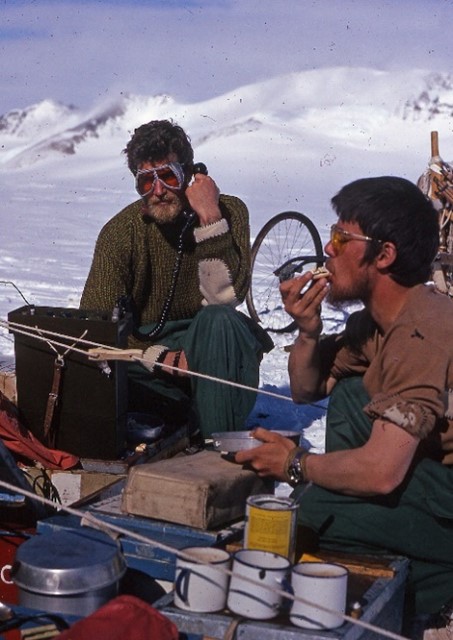


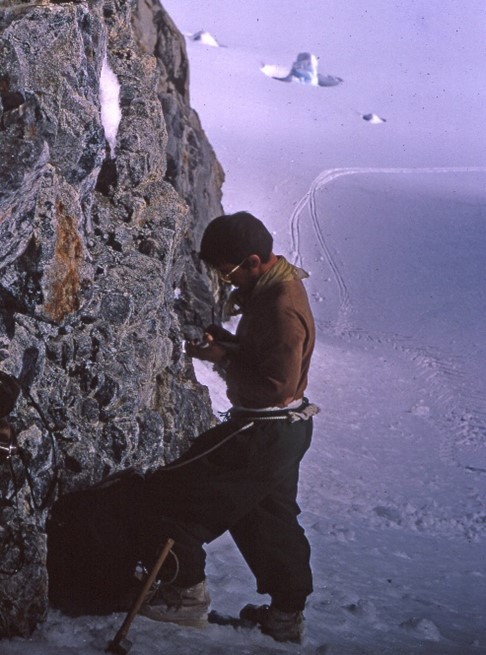
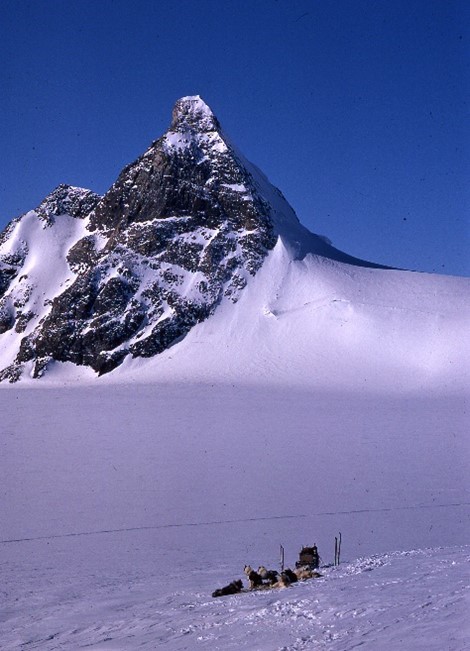

During our 10 week work period the Surveying teams, (Alpha and Charlie) working on sea ice north of us encountered the break-up of sea ice close to Terra Firma. It was important that they head south to gain solid ice and raced to King George V1 Sound. We were asked to assist sledge Alpha and Charlie. On 1st December we RV’d with sledge Foxtrot (Ian Sykes & Ali Skinner) leaving Pete Rowe to stay with them for a few days. Meanwhile Tony and I headed for the Sound down the Chapman Glacier. This had not been sledged before and proved to be fairly straight forward on an excellent surface. On reaching a point near the Sound, where the Glacier met it, we encountered severe crevassing but managed to sledge over a snowy shoulder that was crevasse free. The last slope onto the Sound was very steep and long. Rope brakes were deployed but still quite entertaining. Camped at 06.30 after covering 19.8 miles. A superb day a good experience under our belts and the first blokes to sledge the Chapman Glacier – TICK!
2nd December we headed north and after 5 miles met up with Survey teams Alpha and Charlie. We sat chatting and drinking tea all day and Jack Donaldson with his team the Spartans would join us onto the Plateau for him to join up with Ian Sykes and Ali Skinner. To take advantage of cooler temperatures and better surfaces we left at 0015 on 3rd December. With a slower pace and bad weather we did not RV with Sledge Foxtrot (Sykes & Skinner) until 07.00 on 5th December. We, Sledge Echo, and Sledge Foxtrot separated back to our respective work areas.
Work continued through December and was relatively incident free except for encountering the natural hazards of crevasses and bad weather, and the odd dog fight. However, I found the whole trip challenging. I had a good team but Inca was still struggling in her lead role and this meant when travelling as 2 sledges, with the very strong well established Komats team with Amber as lead dog, the Picts struggled to meet that expectation and followed more than led. Travelling with Peter alone, in support of his work was fine but moving from one area to another as a whole Geology work unit challenged my motivation. Nevertheless, it was only a matter of time before Inca started to fit into her role.
One of the highlights of the whole trip was climbing Mt Courtauld, 6,900’in our work area; a first ascent on the 20th December. Fortunately we were able to sledge, very steeply to 5,500’. Eventually on January 3rd the aircraft (Turbo Beaver) arrived with pilot Bert Conchie, bringing in goodies and taking out 500lbs of rocks and one of my dogs Ramus. It also coincided, quite luckily, with Sledge Foxtrot being replenished with important field gear after they had suffered a fire. Fortunately no-one was hurt. On this day we could safely say that plane table mapping and geologising was complete and we began a 70 mile journey heading home via Charity. Surfaces were very poor and en route Turpin one of my dogs died in harness – reason unknown. Very sad after working all summer. In saying that he wasn’t a particularly hard worker. Our route took is into the Charity area and on 23rd January we were successful in climbing Mt Charity by the steep NE ridge.
By this time we were following the tracks of other teams (Bravo, Delta, Foxtrot) heading home. Eventually travelling via the Weyerhauser Glacier, Mercator Piedmont, Gibbs Glacier, Wyatt Glacier we all arrived at Armadillo Hill 1/2nd Feb and camped. As we all met the discussion focused on the descent we would have to take down the infamous Sodabread slope to get into the NE Glacier.
On Feb 3rd we sledged to the top of the Amphitheatre and a steep descent with chains, rope brake and both keels down to slow our descent. It was a stimulating descent give lots of excitement but no problems – easier than expected. Once in the NE Glacier we had fast surfaces and arrived back at Stonington at 10.00. The end of an excellent trip.
It was back to decent food for us and tasty food for the dogs. The dogs were lean with shiny coats after their long trip and deserved their seal treats…
Rod Pashley, GA, Adelaide 1969 & 1970
